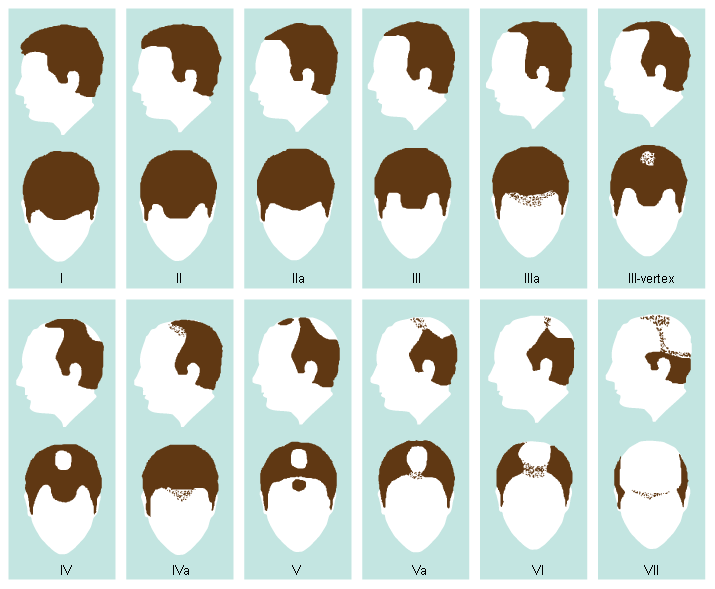Aetiology
The condition was previously considered to be a dominantly inherited disorder with variable penetrance and expressivity. However, it is now clear that androgenetic alopecia is of multifactorial or polygenic inheritance, in which clinical expression represents a threshold effect.[10][11] In women, a link to polycystic ovary syndrome has been found, but polygenic inheritance is also likely.[12][13]
Many genetic studies have been performed, identifying at least 12 genetic regions that associate with androgenetic alopecia in men with candidate genes that include the androgen receptor (AR), histone-deacetylases (HDAC) 4 and 9, and the WNT molecule WNT10A.[11] In women, only a weak association has been found with the androgen receptor (AR) locus, and no association has been found with the other 11 candidate regions found in men.[14]
Pathophysiology
Androgenetic alopecia is characterised by progressive shortening of the anagen growth phase with each hair cycle associated with increased telogen and catagen hair transformation.[15] This process leads to follicular miniaturisation with conversion of long, terminal hairs to short and fine vellus hairs. Several factors have been suggested to play a role in hair growth, but only stem cell factor (SCF) and insulin-like growth factor 1 (IGF1), which is known to induce 5-alpha-reductase, have been found to be altered in response to androgens.[16]
In men, the hair loss is known to be dependent on dihydrotestosterone (DHT), which is irreversibly converted from testosterone by the enzyme 5-alpha-reductase. Of the two isoenzymes of 5-alpha-reductase, type I and type II, a predominance of type II is found within hair follicles in the human scalp.[17] In addition, there is over-expression of androgen receptors in balding compared with non-balding scalps.[18] Prostaglandins have also been implicated in the pathogenesis of male androgenetic alopecia. The enzyme PGD(2)-synthase and its product PGD(2) are elevated in balding scalp skin and PGD(2) has an inhibitory effect on hair growth in animal and in vitro experiments.[11] PGD(2) may stimulate expression of the androgen receptor.[19] In women, the role of androgens and androgen receptors in pattern hair loss has not been completely elucidated.
Classification
Male-pattern baldness (Norwood-Hamilton classification)[1]
Type I: minimal bitemporal recession of hair
Type II: extension of type I
Type III: hair loss in tonsure area and recession of hair from the forehead
Type IV-VI: extension of type III
Type VII: most severe pattern of hair loss, with a confluence of the balding areas; hair preserved only around the back and the sides of the head [Figure caption and citation for the preceding image starts]: The pattern of androgenetic alopecia in men (after Hamilton and Norwood)From the collection of Robert Haber, MD [Citation ends].

Female-pattern baldness (Ludwig classification)[2]
Type I: mild (hair loss on the front and top of the scalp with relative preservation of the frontal hairline)
Type II: moderate
Type III: severe [Figure caption and citation for the preceding image starts]: The pattern of pattern hair loss in women (after Ludwig classification)From the collection of Robert Haber, MD [Citation ends].

Use of this content is subject to our disclaimer